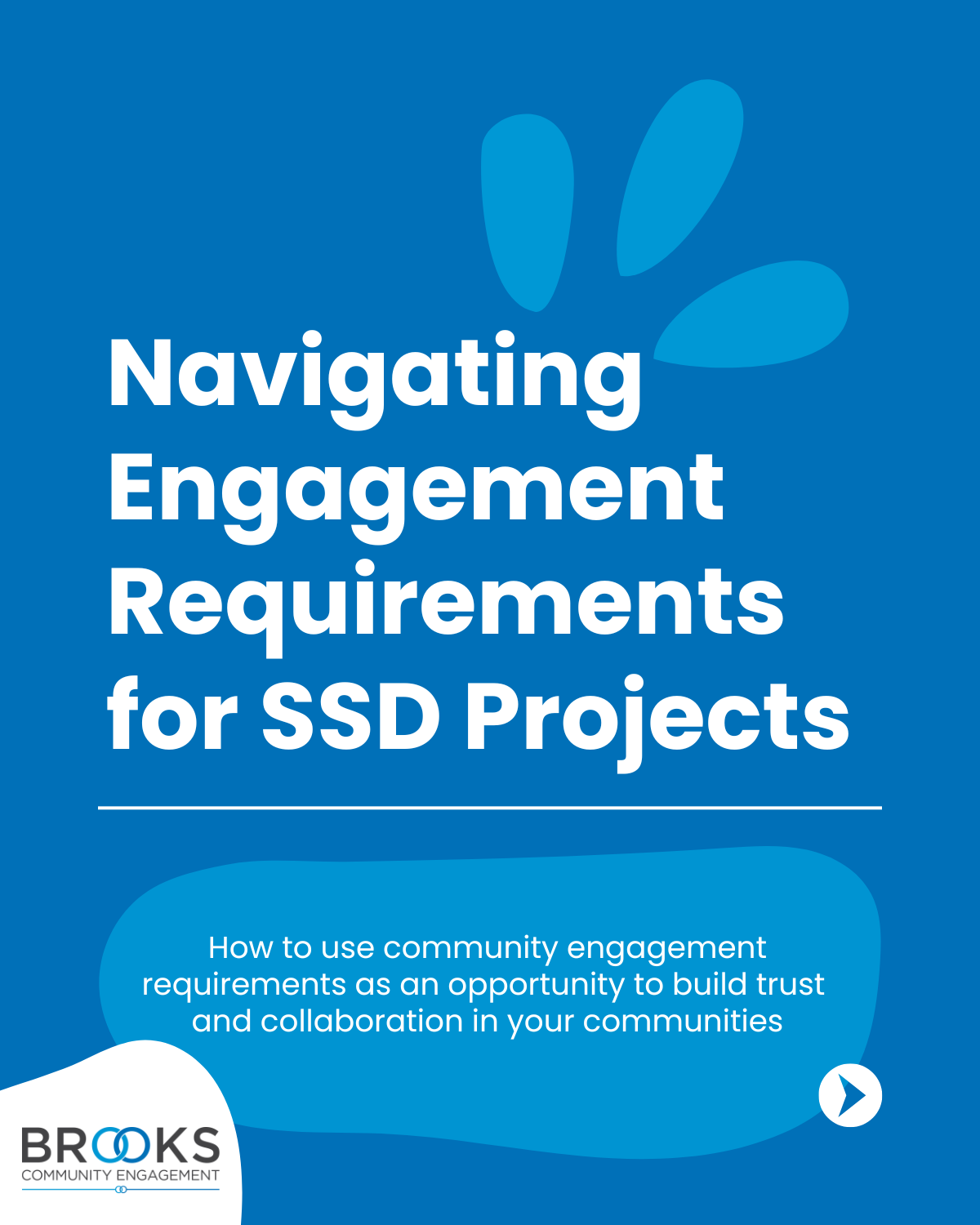Community Engagement Requirements for State Significant Developments (SSD) in NSW
Community Engagement for State Significant Developments
Community Engagement plays a pivotal role in ensuring the success of any project. From small to large scale developments, taking the time to listen and engage with key stakeholders minimises the likelihood of project delays and conflict escalating due to community opposition. In the case of State Significant Developments, there are a myriad of legislative requirements which lay out the groundwork for community engagement to be conducted for SSD projects.
Understanding the Environmental Planning and Assessment Act 1979 (NSW) (‘the EP&A Act’) can be challenging, especially when conducting community engagement activities without clear guidance. In this comprehensive guide, we explain the importance of community engagement, outline the key engagement objectives, and summarise the specific requirements for SSD projects as set out in the EP&A Act and Regulations.
At BROOKS, our engagement approach goes far beyond a mere formality. It is a commitment to comprehensively understanding the diverse needs and priorities of all stakeholders affected by a proposed development. Our approach aims to facilitate civil dialogue, address differences, and ensure alignment with community needs.
Community Engagement Objectives for SSD
As certified Community Engagement Practioners, we advocate adherence to the following objectives for successful engagement in SSD projects in NSW:
To ensure a successful project, it is crucial to begin engaging stakeholders and team members right from the conceptual stage. This early involvement will allow for a comprehensive understanding of the project’s objectives, requirements, and potential challenges. By initiating engagement at this early stage, it becomes possible to gather valuable insights and perspectives, identify any potential risks or opportunities, and establish a solid foundation for the project’s execution. Through open and effective communication, all relevant parties can contribute their expertise, share ideas, and collaborate towards the project’s success. Therefore, it is highly recommended to initiate engagement at the project’s conceptual stage to maximize its potential and achieve the desired outcomes.
To effectively address any concerns and ensure a thorough understanding of the community’s needs, it is highly recommended to involve the community as soon as possible. By actively engaging with community members and seeking their input, a comprehensive understanding of the challenges and issues can be gained. This collaborative approach will not only help in identifying concerns but also foster a sense of ownership and cooperation among all stakeholders involved.
To achieve meaningful outcomes, it is crucial to implement a variety of strategies that are carefully designed and executed. These strategies should be aligned with the overall goals and objectives of the organisation, taking into consideration factors such as market trends, customer preferences, and competitive landscape. By incorporating a comprehensive approach, organisations can maximise their chances of success and create a positive impact in their respective industries. It is important to continuously evaluate and adjust these strategies, as the business environment is constantly evolving. By staying agile and proactive, organisations can stay ahead of the curve and achieve long-term success.
To maximise the effectiveness of the project, it is important to customise and adapt the level of engagement according to the scale and impact of the project. By tailoring the engagement strategies and activities to suit the specific project requirements, we can ensure that the project’s goals are met and that the desired outcomes are achieved. This approach allows for a more comprehensive and thorough implementation, taking into consideration the unique characteristics and complexities of the project. Additionally, by carefully considering the scale and impact of the project, we can identify opportunities for further expansion and growth, paving the way for long-term success and sustainability.
To truly cultivate authentic connections, it is essential for organisations to not only meet the minimum obligations outlined in the EP&A Act but to go above and beyond these requirements. By exceeding the standards set forth by the legislation, organisations can actively nurture meaningful and lasting relationships with their stakeholders. This can involve implementing additional initiatives, adopting more comprehensive strategies, and taking proactive measures to engage and collaborate with partners. By going the extra mile, organisations can create an environment that fosters genuine connections and establishes a solid foundation for success.
Clearly and effectively communicate all aspects of the project that have been influenced by the community. This includes but is not limited to gathering feedback, incorporating suggestions, and implementing ideas proposed by community members. It is important to ensure that the community’s contributions are acknowledged and valued throughout the project development process.
Community Engagement Requirements for State Significant Developments (SSD)
State Significant Developments (SSD) hold significant importance for New South Wales, contributing to the state’s economic, environmental, and social objectives. To initiate any SSD project, it is crucial to obtain development consent under the Environmental Planning and Assessment Act 1979 (EP&A Act) from either the Independent Planning Commission or the Minister for Planning. Prior to approval, SSD projects undergo a comprehensive assessment process, which includes extensive community participation. Below, we will delve into the specific requirements governing these processes.

1. SEARs (Secretary’s Environmental Assessment Requirements)
SEARs (Secretary’s Environmental Assessment Requirements) define the engagement process during the preparation of the Environmental Impact Statement (EIS). They ensure that the level of engagement is proportionate to the scale and likely impacts of the project. Proponents are required to engage with the community, councils, and government agencies, and document their responses to raised issues. Project-specific SEARs, tailored to each project, are crucial and should be informed by a scoping report that indicates community views.
If a SSD (State Significant Development) project is eligible for industry-specific SEARs, the proponent must engage with the community, relevant councils, and government agencies during the preparation of the EIS. The proponent must also document how they have considered and responded to the raised issues, as well as how the project has changed in response to feedback.
For all other State significant project applications, project-specific SEARs are required. The engagement requirements will be tailored to the specific circumstances of the project. To inform the setting of project-specific SEARs, the proponent must submit a scoping report to the Department along with their SEARs application. This scoping report should provide an early indication of community views on the project and identify the engagement activities to be carried out during the preparation of the EIS.

2. Environment Impact Statement (EIS)
The Environmental Impact Statement (EIS) assesses the economic, environmental, and social impacts of a project. It plays a crucial role in helping the community, councils, government agencies, and the consent authority to gain a better understanding of the project and its potential effects. This understanding allows them to make informed decisions or submissions regarding the merits of the project.
The applicant is required to provide a detailed description of the community engagement activities that took place during the preparation of the EIS. This should include identifying the key stakeholders involved in the project, outlining the specific community engagement initiatives undertaken, and explaining how these efforts align with the community participation objectives outlined in the Undertaking Engagement Guidelines for State Significant Projects, as well as the community engagement requirements specified in the relevant SEARs.
Furthermore, the applicant should provide a concise summary of the key findings resulting from the community engagement conducted during the EIS preparation. It is important to present community views on the project using appropriate maps, figures, graphics, and tables.
Lastly, the applicant should summarize the community engagement activities that will be carried out if the project receives approval. This summary should take into account the findings from the community engagement conducted during the EIS preparation and should align with the community participation objectives stated in the Undertaking Engagement Guidelines for State Significant Projects.

3. Public Exhibition Period
The Environmental Impact Statement (EIS) is a crucial document that needs to be made available to the public for a substantial period of time. To ensure widespread accessibility, it is required that the EIS is publicly exhibited on the major projects’ website for a minimum duration of 28 days. This extended period allows the community ample opportunity to review the EIS in detail and provide their valuable feedback. The feedback received from the community will then be published on the major projects’ website, ensuring transparency and accountability throughout the decision-making process.
Moreover, in accordance with the regulations, an application seeking to modify an SSD development consent is required to undergo a mandatory public exhibition period. During this period, the application is made available for public scrutiny and feedback for a minimum duration of at least 14 days. This allows for ample opportunity for stakeholders and members of the public to review and provide their input on the proposed modifications to the SSD development consent.

4. Mandatory Responses to Submissions
The proponent is required to respond to the issues raised in submissions during the Public Exhibition Period. The proponent will prepare a submissions report which analyses the issues raised and describes the actions that have been taken to address those issues. This report will help the community, councils and government agencies understand how the issues they raised have been addressed by the proponent.

5. Evaluation of the Development Application
When determining a project, it is crucial for the consent-authority (the Minister or the IPC) to thoroughly consider the various issues that have been raised in the submissions. This applies to all submissions, regardless of the submitter’s identity or the number of submissions received. By giving equal importance to every submission, the decision-maker ensures fairness and transparency in the decision-making process.
Furthermore, it is imperative for the decision-maker to provide clear and comprehensive reasons for their decision. This includes a detailed explanation of how the submissions were taken into account and the factors that influenced the final decision. By doing so, the decision-maker not only demonstrates their commitment to accountability but also helps stakeholders understand the rationale behind the chosen course of action.
In summary, the decision-making process for a project requires careful consideration of all submissions, irrespective of the submitter’s identity or the quantity of submissions. Additionally, providing comprehensive reasoning that highlights the impact of the submissions on the decision is essential for fostering transparency and understanding among stakeholders.
Ready to navigate your SSD project’s community engagement requirements with ease? Contact BROOKS today to discover how our expertise can help you comply effectively. Let’s ensure your project’s success together!
Community Engagement Requirements for State Significant Developments (SSD) in NSW

Additional Resources:

